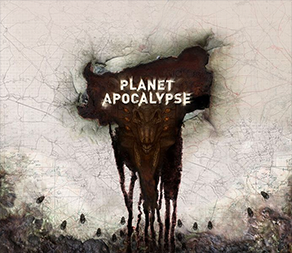Review copy provided by CGE
Sanctum is a new game designed by Filip Neduk and published by Czech Games Edition. It is a demon-slaying adventure game inspired by games like Diablo from the hack-and-slash genre. Two to four players will spend one to two hours fighting off the swarms of demons around the city of Sanctum before pushing through to fight the Demon Lord. The game combines character leveling, resource management with Stamina and Focus, as well as dice rolling and modifying.
Four different heroes utilize vastly different fighting styles and it will be up to the players to rely on their strengths and mitigate their weaknesses.
The healthiest hero alive at the end—or the one who made it the furthest before perishing—is the winner.
Sanctum feeds off the same energy as hack-and-slash action RPGs. Is it as fun?
STORY
In ancient times, the legends say, the land was seized by the Demon Lord Malghazar. His infernal minions swarmed the earth and laid waste to all that humankind had built.
But from the ruins arose great heroes. They battled through the demonic hordes and fought their way to Malghazar himself. Through courage, luck, and raw magical power, they defeated the Demon Lord and sealed him inside the Jade Sarcophagus.
Atop this deathless tomb, the land’s new rulers built a city—a monument to their victory. They wished their city to forever be a safe haven, and so they named it Sanctum.
Is anyone else thinking of Marius from Diablo II as the narrator? That’s all I could imagine when reading the backstory to Sanctum. A once-gorgeous but now-blurry PC cutscene showing the deeds of heroes. And speaking of heroes. The ones we’re reading about seem to have gotten the job done. So that’s it, right? No need to get sharpen the swords or hoard the potions. Fight’s over?
Nope!
When the horrors had faded to legends and the Jade Sarcophagus had been forgotten, the throne of Sanctum fell to a king both weak and foolish. Though ruler of a bountiful land, the king saw visions of even greater power—power that lay buried somewhere beneath his city. And so began the frenzied digging—buildings torn down and streets dug up in search of a mad man’s hallucination.
But the vision proved true. The king did find the power. He found it sealed underground, and he broke the seal with his own hands.
The Jade Sarcophagus has been opened. Who will come to the aid of Sanctum?
Ahh, that makes more sense. So we’re not the first heroes. We’re the second-string heroes, here to redo the job that was already done. After all, evil doesn’t sleep forever.
Classic fantasy trope. Oh well, let’s get demon-killing.
GAMEPLAY
Sanctum centers on three actions—moving, fighting, and resting. Players have a choice of one during their turns. Everything else revolves around those three possibilities.
When you move, you reveal more demons on the path to Malghazar. And then you have to add demons to your player board; these creatures are now pursuing you.
When you fight, you turn toward the pursuing demons and fight—rolling dice, modifying them, assigning hits to demons, blocking damage, and gaining the levels and rewards that come with killing demons.
When you rest, you restore the Stamina and Focus you used during your fights, you equip items, and buy potions for use during a fight.
After fighting and resting, you also check achievements that track player progression. These one-time rewards can be used at the end of the game.
The rest of Sanctum may seem visually complex, but it all hinges on those basic principles and it can be easily deciphered, taught, and played within thirty minutes or less, depending on your familiarity with board games.
Stamina and Focus are the core resources used to modify dice rolls and defend against damage. Those are augmented by items acquired when defeating demons, which are powered by the gems that you get when defeating demons. Clearing gems off your player board unlocks skills which further help a hero when fighting demons.
It’s all connected and it can look like a lot, but it’s a relatively straightforward game.
It’s a hack-and-slash game turned into a tabletop experience. You fight less powerful demons. The encounters level up your character and provide gear to strengthen your fighter. Then you fight stronger enemies. And you collect mid-tier items while continuing to level. Until you face powerful enemies with really good loot. By that time, you’re reaching the highest levels. And all of that prepares you for the final fight against the Demon Lord. It’s a game of increasing difficulty.
One of the strengths of Sanctum is the diversity of the heroes. Each one has a unique playstyle so no two players will approach combat with the same mindset. The Huntress, the Outlaw, the Slayer, and the Dancer all manipulate the mechanics in different ways—one might rely on Rage more heavily while the other takes advantage of Stamina and Focus to their benefit, and still another might modify dice in strategic ways before a fight even starts.
You’ll be able to enjoy the game multiple times without feeling like you’re playing the same way. And the method of unlocking skills and using gems to equip items does make me feel like I’m playing Diablo again (without the perpetual struggle to organize things in my inventory window).
I will say, though, that the difficulty does ramp up massively from the first acts to the final encounter with the Demon Lord. What is a relatively smooth journey through demon-infested lands, as your character levels up and gets new shiny weapons and durable armor, quickly heats up into a fiery challenge at the end. It’s akin to starting off a game on easy or normal difficulty before switching it to perma-death for the boss fight.
Fighting the demons is set at the pace of the player. They choose the time and place of the battle. And they decide how many demons to be in pursuit before fighting them. This means that a fight rarely feels unfair or out of balance. It’s usually possible to kill all or most of the demons on your player board and deflect all incoming attacks to avoid taking damage.
And that’s essential. Because you won’t be able to avoid damage in the boss fight. The Demon Lord hits hard. Many times over. Whereas a demon is one card that you must overcome to win, the Demon Lord will have a dozen or more cards that players will have to slog through in order to claim victory. And they hit harder than anything else in the game. Rightly so. It’s the boss, after all. But it’s a huge spike in adversity.
This is where my main issue with Sanctum comes into play. I’m not afraid of a difficult boss fight. Or a challenging endgame. I like tough opponents in video games. I enjoy the Souls-like trudge through loss and despair. But it’s a sharp deviation from the beginning of the game. This makes the first two-thirds of the game merely a preparation phase for the final fight. Get the best loot and the most amount of levels from the demons on the way in order to have the best chance of winning, or simply surviving, against the Demon Lord.
That’s not the worst thing, but it does alter my perspective a little. Instead of an engaging experience of competitive board gaming with other players, it’s a means to an end. It’s practice before the official match. Stretching before an activity.
Two distinct parts that sometimes don’t feel like a whole. And that design choice is reinforced by the difficulty ratings. Whether you pick normal, hard, nightmare, or inferno, the only change is in the number of initial cards that the Demon Lord throws at the heroes. It doesn’t affect any other aspect of the game. Just part of the boss fight. Which is a little disappointing and it underscored that feeling of a fragmented game.
Don’t get me wrong, if you’re looking for Diablo in a box for tabletop gaming or an innovative love letter to the hack-and-slash genre, then Sanctum will scratch that itch. It will serve that purpose.
But there’s something missing.
VISUALS
You will feel like you’re slaying demons and stopping the apocalypse in Sanctum. The dark rulebooks, hero references, and player boards all have the grim coloring of a dungeon-crawling, hack-and-slash experience. Deep reds and oranges burn from the table as the heroes near the Demon Lord, and the magical or physical abilities of the heroes are illustrated in deep blues, forest greens, smoldering reds, and murky yellows.
The thick construction of the player boards and map tiles are durable, so you’ll be able to get a lot of play out of the game. And the components are mostly plastic, so they’ll be able to survive some spills when your overeager Slayer friend spills their beer (or whatever they’re drinking).
All in all, I liked the presentation of Sanctum. Everything fit in the box, and it was easy to set up and distinguish all of the individual parts of the game. Filip Neduk has created an alluring world, and CGE has done a great job in publishing a game designed to bring that world to life.
REPLAYABILITY
The four heroes do give some depth to the game. No two of them are alike. They use the same resource pools of Stamina and Focus—though in different amounts according to their playstyle—and the items are all acquired by fighting the same demons, but the choices that each hero can make while fighting will introduce variability to a game.
That being said, the path of each game will remain the same. The same spots on the same act boards will be traced by the heroes as they journey toward the Demon Lord. So, without expansions or additional content, Sanctum could become stale after some time. If this stays a standalone game, then it would be hard to convince my gaming friends to play it frequently.
WHAT IT COULD HAVE DONE BETTER
I think adjusting the balance of the game would benefit Sanctum greatly. Maybe increasing the challenge of the middle acts, with some mini-boss perhaps, and lowering the tenacity of the final encounter with the Demon Lord would all provide the game with a more even pace. Right now it’s like switching from light jog to a sprint. Some build-up would be nice.
Again, that could be achieved with some mid-tier bosses, some expansion cards, some in-game events. Something to spice up the beginning and middle acts and to create more of a narrative. That’s something that Diablo did well. It created an engrossing story that kept me immersed in the world. The demon-slaying and leveling up made sense in the context of a wider narrative. And it helped to tie the grinding in the game to the final boss fights.
Some re-working is in order. If that was achieved in a second edition or with expansions, then Sanctum could really be something.
VERDICT
Sanctum brings hell to the table and the final encounter with the Demon Lord can be one of the more challenging tabletop fights you’ll experience. If you want an exciting rush for glory in the hopes of vanquishing the Demon Lord before other players or die trying, then it will certainly deliver the spectacle and enjoyment.
It does feel like after a certain amount of play, gamers could get tired of the formula in which the heroes must push through the early acts to accrue stronger gear and unlock abilities for the final fight. That means-to-an-end feeling never quite went away.
Maybe in a revised edition or future expansions, Sanctum could grow into a truly addictive experience.





















